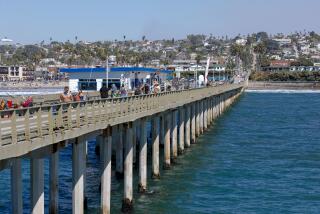City Must Take Plunge on Revamping Plunge
A constant challenge of modern American cities is to strike the proper balance between preserving those historical buildings with architecture that is truly worthy of the ages and making room for contemporary development designed to meet todayâs needs.
Examples of wise decisions made in San Diego include saving most of the beautiful âtemporaryâ buildings from the 1915 Panama-California Exposition in Balboa Park but sacrificing the old Lyceum Theatre in favor of the Horton Plaza shopping center and its two new theaters. Not everyone, of course, agrees that either of these cases represents stellar urban planning, but then, unanimity is rare when development versus preservation is at issue.
For several years, just such a controversy has divided opinion over what to do with Mission Beach Park, site of the Belmont Park roller coaster, the Mission Beach Plunge and the roller rink building. After several years of discussion and refinement of plans, the City Council voted last June to allow developers Paul Thoryk, Graham MacHutchin and Steve Davis to raze the roller rink and the outer portions of the Plunge building and replace them with a new structure around the huge swimming pool, and seven smaller buildings that would house a farmerâs market and shops. Restaurants would be located at the two beachfront corners of the new Plunge building.
The Mission Beach Town Council and others favoring historical restoration of the buildings have long opposed commercial redevelopment of the area. They mounted a successful petition campaign to place a referendum on this Novemberâs ballot, allowing voters the opportunity to veto the plans. The trouble is that the city already has given its approval and entered into a contract with the developers, and the initiative contains language that makes it void if the developers have obtained a âvested rightâ in the project by the date the initiative is enacted. In other words, if the project is well under way, the referendum is moot.
In a public hearing Monday, the City Council will consider the option of adopting the language of the initiative--making it law without a popular vote--or placing it on the ballot. Mayor Maureen OâConnor tried last week to get the council to allow the city manager to delay issuing the projectâs demolition permits until after Mondayâs hearing, but she failed, and it appears that a solid majority of the council will vote to place the initiative on the ballot, thereby probably rendering it moot.
We agree that the project should go forward. The roller rink is closed and dilapidated and adds nothing in the way of beauty to the area; the Plunge building is deteriorating and in need of expensive structural updating. The roller coaster is not part of the redevelopment plan, but is in the hands of a separate group that is trying to raise money to restore it aesthetically, if not operationally.
The Plunge excites a good deal of emotion from beach-area residents, and understandably so. It is a 62-year-old institution that has been the site of good times for many San Diegans. With the pool area remaining just as it is, those good times can begin again when the new project is completed.
Although the developers will re-create the Plunge buildingâs significant architectural elements in the new plaza, we would not argue that it will have the same kind of funky charm that exists there now. But todayâs funky charm is tonightâs hangout for drug dealers and tomorrowâs falling-down eyesore.
Mission Beach Park was built by John D. Spreckels in 1925 as a commercial amusement park. It does no violence to his original vision to allow it now to become a place where people can go to have fun and enjoy the beach.
More to Read
Sign up for Essential California
The most important California stories and recommendations in your inbox every morning.
You may occasionally receive promotional content from the Los Angeles Times.










